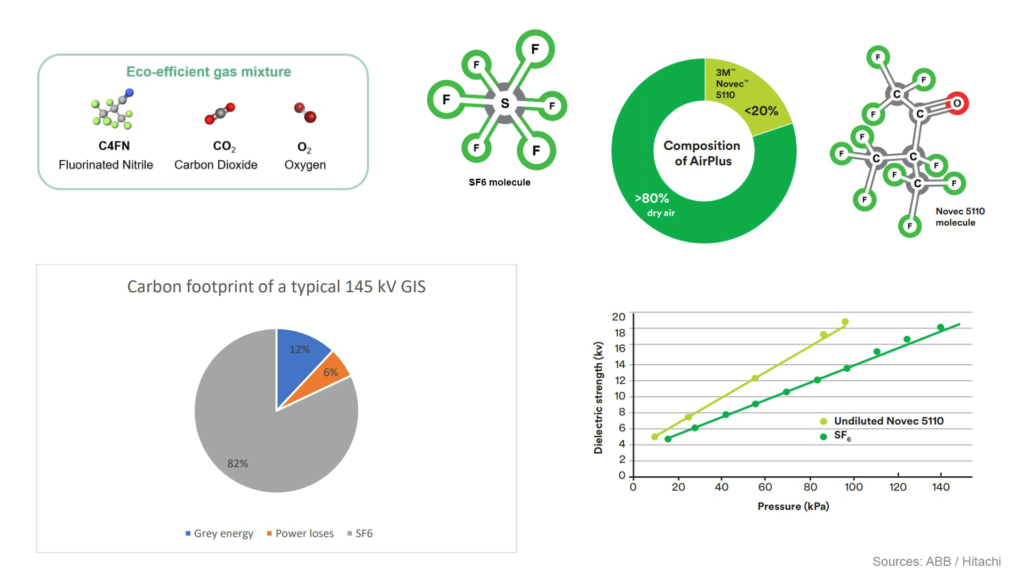Sulphur hexafluoride (SF6) gas is an excellent electrical insulator with outstanding arc quenching capabilities. The dielectric strength of SF6 increases with pressure, which allows for smaller apparatus that can be used at higher voltages.
Gas-insulated switchgear has the advantage of a much smaller footprint, taking up less expensive real estate compared to non-gas installations. SF6 circuit breakers are also very reliable and require less maintenance than air blast or oil breakers.
With gas-insulated design, several components are incorporated within a closed gas tank. This protects against unwanted environmental matter, like dust, humidity, or animals, making gas insulated apparatus nearly maintenance free over the span of their service life.
For these reasons and more, the demand for SF6 equipment has grown, making it the “standard” gas for electrical insulation.

Is SF6 Gas Dangerous?
SF₆ is a man-made gas that does not naturally occur in large quantities. In addition to outstanding dielectric properties, SF6 gas is generally safe to handle. It is colorless and odorless, chemically stable, non-toxic, and temperature-resistant up to 500°C.
In recent years, the potential climate impact of SF6 gas has led to a steady increase in demand for Eco-friendly alternatives. SF6 has been listed as an extremely potent greenhouse gas according to the Kyoto protocol, with 23,500 times the comparative Global Warming Potential of CO2 and a lifetime of 3,200 years in the atmosphere.
The Global Warming Potential (GWP) of a gas measures the amount of energy the emissions of 1 ton of that gas will absorb relative to 1 ton of carbon dioxide (CO2). Gases with a higher GWP contribute more significantly to climate change.
Are there alternatives to SF6?
Due to the climate impact of SF6 gas, the demand for alternatives has been increasing as part of a collective effort to reduce the usage of greenhouse gases. The most popular options are purified air and gas mixtures that both provide minimal climate impact when compared to SF6.
Systems with clean air as an insulating gas may take up more space than SF6 but the use of vacuum switching can help further reduce equipment footprint and increase performance. Clean air systems can also offer a shorter arcing time compared to SF6, which leads to less wear and tear on the system.

GE g3
Pronounced “g-cubed,” g3 insulating gas from GE has been developed for HV electrical transmission equipment an insulating gas by 3M called Novec 4710. These products feature the same ratings and same dimensional footprint as their SF6 counterparts, with more than 99% less global warming potential.
GE claims that their g³ products have a significantly improved life cycle assessment compared with SF6 products and other alternatives. There is no major increase of raw materials and therefore no pollution transfer induced on any other environmental indicators.
Similar to SF6 gas, “g3” insulation is non-toxic and not flammable. It also falls into the same safety class as SF6. Gas-Insulated Lines are available up to 420kV and operate with no restriction under the same temperature range as SF6 products (down to -30°C).
ABB Air Plus
Another Eco-efficient SF6 alternative called “AirPlus” has been developed by ABB, using 3M Novec 5110 for use in MV Primary GIS up to 40.5kV and in MV Secondary GIS and AIS up to 24kV.
AirPlus insulation gas contains more than 80% dry air, with less than 20% Novec 5110, the special fluoroketone molecule developed by 3M. This medium combines good electrical insulation properties with a negligible GWP of <1.
Concentrated Novec 5110 gas outperforms SF6 in terms of electrical insulation performance but Air Plus is mixed with a background gas in order to extend its usable temperature range. This allows for typical temperature demands of indoor switchgear to be achieved with performance similar to that of SF6 gas.
Hitachi EconiQ
EconiQ by Hitachi ABB Power Grids uses 3M Novec 4710 to create an Eco-efficient gas mixture containing Flourinated Nitrile (C4FN), Carbon Dioxide (CO2), and Oxygen (O2).
In pure form, Novec 4710 has roughly twice the electrical strength of SF6 at a given pressure. Gas mixtures are created to have a minimum operating temperature of −30 °C and to achieve a CO2 equivalent reduction of >99% compared to SF6.
Hitachi notes that existing SF6 service carts/gas pressure sensors, and gas analyzers are not designed for use with C4-FN mixtures. Connections used for C4-FN mixtures are different from those used for SF6 to avoid gas handling mistakes.
Siemens Clean Air
Sometimes also called “dry air,” Siemens Clean Air is a processed and purified air mixture consisting of 80% nitrogen and 20% oxygen. This product has zero greenhouse gas potential and is completely harmless to health and the environment.
Clean Air is mainly used to insulate current-carrying conductors inside housings: for example, in air-insulated instrument transformers, circuit breakers, and gas-insulated switchgear. Siemens is also using the gas as an insulation medium for circuit-breakers based on vacuum-interruption technology.
The mixture replaces SF6 as an insulation medium, eliminating the need for handling, recycling, and reporting as required by law when using SF6 and other F-gases in some parts of the world.
